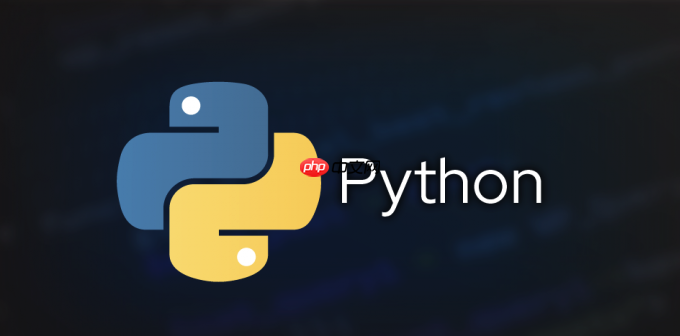Python实现简单Web服务器主要依赖http.server模块,适用于开发测试。通过继承BaseHTTPRequestHandler可处理GET/POST请求并返回动态内容,但该模块存在单线程性能瓶颈、功能缺失及安全缺陷,不适合生产环境。推荐使用Flask、FastAPI等轻量级框架替代,它们提供路由、异步支持、数据验证等高级功能,更适合构建实际应用。

Python实现一个简单的Web服务器,主要依赖其内置的
http.server
要实现一个简单的Web服务器,我们通常会用到Python标准库中的
http.server
最基础的用法是搭建一个静态文件服务器,这简直是秒级操作。你只需要在命令行里切换到你想要共享的目录,然后运行:
python -m http.server 8000
这样,你的当前目录下的所有文件就可以通过
http://localhost:8000
立即学习“Python免费学习笔记(深入)”;
如果我们需要更精细的控制,比如处理不同的URL路径,或者响应POST请求,那就需要自己写一点Python代码了。我们通常会继承
http.server.BaseHTTPRequestHandler
do_GET
do_POST
这是一个简单的“Hello, World!”服务器示例:
import http.server
import socketserver
import json # 可能会用到,比如处理JSON数据
PORT = 8000
class MyHandler(http.server.BaseHTTPRequestHandler):
def _set_headers(self, status_code=200, content_type='text/html'):
self.send_response(status_code)
self.send_header('Content-type', content_type)
self.end_headers()
def do_GET(self):
# 实际开发中,这里会有路由逻辑,根据self.path判断请求哪个资源
if self.path == '/':
self._set_headers()
self.wfile.write(b"<h1>Hello, World! This is a GET request.</h1>")
elif self.path == '/api/data':
self._set_headers(content_type='application/json')
response_data = {'message': 'This is dynamic data from GET.', 'status': 'success'}
self.wfile.write(json.dumps(response_data).encode('utf-8'))
else:
self._set_headers(404)
self.wfile.write(b"<h1>404 Not Found</h1>")
def do_POST(self):
content_length = int(self.headers['Content-Length']) # 获取POST请求体长度
post_data = self.rfile.read(content_length) # 读取请求体
self._set_headers(200, content_type='application/json')
try:
# 尝试解析JSON数据,如果不是JSON,可能需要urllib.parse.parse_qs
data = json.loads(post_data.decode('utf-8'))
response_message = f"Received POST data: {data}"
response_data = {'message': response_message, 'status': 'success'}
self.wfile.write(json.dumps(response_data).encode('utf-8'))
except json.JSONDecodeError:
response_message = f"Received raw POST data: {post_data.decode('utf-8')}"
response_data = {'message': response_message, 'status': 'error', 'detail': 'Could not parse JSON'}
self.wfile.write(json.dumps(response_data).encode('utf-8'))
# 启动服务器
with socketserver.TCPServer(("", PORT), MyHandler) as httpd:
print(f"Serving at port {PORT}")
httpd.serve_forever()
这段代码里,
MyHandler
BaseHTTPRequestHandler
do_GET
do_POST
_set_headers
self.path
self.headers
self.rfile
self.wfile
虽然Python的
http.server
首先是性能问题。默认情况下,
http.server
socketserver.ThreadingTCPServer
ForkingTCPServer
其次是功能上的欠缺。
http.server
再者是安全性考量。这个模块没有内置任何生产级别的安全特性,比如HTTPS支持、防止常见的Web攻击(如XSS、CSRF、SQL注入等)的机制。在生产环境中直接使用,会面临很大的安全风险。错误处理也比较基础,可能无法很好地应对各种异常情况。
因此,我个人觉得,
http.server
在
http.server
BaseHTTPRequestHandler
do_POST
self.rfile
self.wfile
处理POST请求的步骤大致是这样的:
Content-Length
int(self.headers['Content-Length'])
self.rfile.read(content_length)
Content-Type: application/x-www-form-urlencoded
urllib.parse.parse_qs
Content-Type: application/json
json.loads
Content-Type: multipart/form-data
http.server
self.send_response
self.send_header
Content-Type
application/json
text/html
self.wfile.write()
回到我前面给出的
MyHandler
do_POST
def do_POST(self):
content_length = int(self.headers['Content-Length']) # 获取POST请求体长度
post_data = self.rfile.read(content_length) # 读取请求体
self._set_headers(200, content_type='application/json') # 假设我们总是返回JSON
try:
# 尝试解析JSON数据
data = json.loads(post_data.decode('utf-8'))
response_message = f"成功接收到POST数据: {data}"
response_data = {'message': response_message, 'status': 'success', 'received_data': data}
self.wfile.write(json.dumps(response_data).encode('utf-8'))
except json.JSONDecodeError:
# 如果不是JSON,或者JSON格式错误
response_message = f"接收到非JSON或格式错误的POST数据: {post_data.decode('utf-8', errors='ignore')}"
response_data = {'message': response_message, 'status': 'error', 'detail': '请求体不是有效的JSON格式'}
self.wfile.write(json.dumps(response_data).encode('utf-8'))
except Exception as e:
# 其他未知错误
response_data = {'message': f"处理POST请求时发生错误: {e}", 'status': 'error'}
self.wfile.write(json.dumps(response_data).encode('utf-8'))这段代码已经比较清晰地展示了动态处理POST请求的核心逻辑。通过这种方式,我们可以在服务器端接收数据,进行处理(比如保存到内存、文件或数据库),然后返回一个定制化的响应。
http.server
当我们发现
http.server
我个人比较推荐的有:
Flask:这是一个“微框架”,它的核心非常小巧,只包含Web应用最基本的功能,比如请求路由和模板渲染。它不强制你使用特定的数据库或ORM,你可以根据自己的喜好选择组件。Flask以其灵活性和简洁性而闻名,非常适合构建RESTful API或者小型Web应用。它的学习曲线非常平缓,社区活跃,有很多扩展可用。
一个极简的Flask应用:
from flask import Flask, request, jsonify
app = Flask(__name__)
@app.route('/')
def hello_world():
return 'Hello, Flask World!'
@app.route('/api/echo', methods=['POST'])
def echo_post():
if request.is_json:
data = request.get_json()
return jsonify({'received': data, 'status': 'success'}), 200
return jsonify({'error': 'Request must be JSON'}), 400
if __name__ == '__main__':
app.run(debug=True, port=8000)你看,用Flask处理GET和POST请求,特别是JSON数据,是不是感觉舒服多了?它抽象了很多底层细节。
FastAPI:这是一个相对较新的Web框架,但它凭借出色的性能和现代化的设计迅速流行起来。FastAPI基于ASGI(Asynchronous Server Gateway Interface),这意味着它天生支持异步请求处理,性能非常高。它还集成了Pydantic进行数据验证和序列化,并能自动生成OpenAPI(Swagger UI)文档,这对于构建API服务来说简直是神器。如果你对异步编程有一定了解,并且追求高性能的API,FastAPI绝对是首选。
一个FastAPI的例子:
from fastapi import FastAPI
from pydantic import BaseModel
app = FastAPI()
class Item(BaseModel):
name: str
price: float
is_offer: bool = None
@app.get("/")
async def read_root():
return {"message": "Hello, FastAPI World!"}
@app.post("/items/")
async def create_item(item: Item):
return {"item_name": item.name, "item_price": item.price}
# 运行方式:uvicorn main:app --reload --port 8000FastAPI通过类型提示和Pydantic,让数据验证和文档生成变得异常简单和强大。
Bottle:如果你觉得Flask还不够轻量,那么Bottle可能适合你。它是一个非常小巧、快速、简单的WSGI微框架,所有代码都包含在一个Python文件中。它没有外部依赖,非常适合构建小型、独立的Web应用。
这些框架都比
http.server
以上就是Python怎么实现一个简单的Web服务器_Python内置库搭建Web服务指南的详细内容,更多请关注php中文网其它相关文章!

每个人都需要一台速度更快、更稳定的 PC。随着时间的推移,垃圾文件、旧注册表数据和不必要的后台进程会占用资源并降低性能。幸运的是,许多工具可以让 Windows 保持平稳运行。

Copyright 2014-2025 https://www.php.cn/ All Rights Reserved | php.cn | 湘ICP备2023035733号